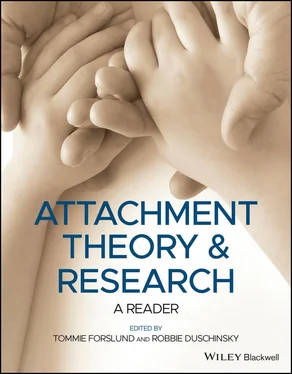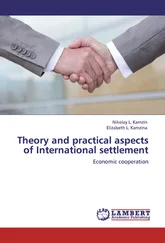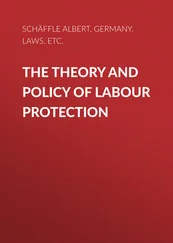Although I believe such views to be theoretically plausible and, so far as there are relevant data, empirically well based, it must be recognized that they are not those which have been advanced by leading psycho‐analysts, many of whom have thought that the growth of independence is impossible without the frustration of earlier needs. Freud held that it is possible to give a child too much affection and that it is this which prolongs the phase of dependence and promotes increased separation anxiety; a critique of this view is postponed to the next section. Melanie Klein shares the same outlook but invokes a different mechanism. In questioning how the child ever detaches himself from his mother, she suggests that ‘the very nature of this overstrong attachment … tends to drive him away from her because (frustrated greed and hatred being inevitable) it gives rise to the fear of losing this all‐important person, and consequently to the fear of dependence upon her’ (Klein & Riviere, 1937). Although a process of this kind is well known as one which underlies a premature development of independence, 19 I believe it to be the result of avoidable frustration and to lead to independence of a special and often pathological kind. I know of no reason to suppose it is responsible for its healthy growth.
As regards the second component of the long‐term changes, the increasing range of objects toward whom attachment behaviour is directed, probably this is also a result both of maturational change and of learning. Thus the very capacity to include, even at a lower level of preference, a number of different people is something which may well become increased between, say, 18 months and 3 years by maturational processes. Even so, precisely who is included is obviously learned, and the number who become trusted by any particular child, whilst always limited, is evidently in large part the result of experience.
Once again it is instructive to hear of comparable changes in chimpanzees. Reading Yerkes’s account, one gains the impression that, in chimps, initially the shift may be entirely one of object and that intensity of response remains unchanged. Generalizing again from his observations of chimps in captivity, he writes of the developing infant: ‘Gradually a striking change in behaviour becomes evident. The initial specific clinging dependence upon the mother gives place rapidly to a generalized dependence on the extending social environment. … Need for social stimulation, such as is provided by companions, becomes so strong during late infancy and early childhood that isolation causes varied symptoms of deprivation.’ As the chimpanzee child grows older, however, the intensity of the attachment responses themselves seems to diminish: ‘Maternal dependence normally is outgrown during infancy, and similarly, extreme social dependence tends to be outgrown during childhood and adolescence.’
Primary anxiety arising from separation either from mother‐figure or companions is thus a function of age. The period when the individual is especially vulnerable is whilst the response systems mediating attachment and escape are not only easily activated at high intensity but are narrowly directed towards one, or at most a few, figures. Once there is a diminution in the readiness with which the response systems are activated, or the growing child, chimp or human, becomes able to accept temporary substitutes more readily, vulnerability decreases. So far as my own observations go, I have the impression that in humans these changes do not often take much effect until the child has reached about 2 years 9 months, though the age varies considerably from child to child.
Origin of Separation Anxiety of Pathological Degree
Earlier in the paper I have made it clear that, on the hypothesis advanced, primary anxiety will occur whenever any (or at least one of a number of) instinctual response systems is activated and not terminated. The primary anxiety arising when a young child is separated from his mother is thus only a special case of a more general phenomenon. Nevertheless, clinical experience suggests that it is of peculiar pathogenic significance and, if this is so, the problem remains why it should be so. The following explanation appears plausible. In the first place, the phase during which the human infant’s capacity for locomotion is limited is a long one. As a result, whether or not his attachment responses are terminated turns for some years on the initiative of others, especially his mother: he is entirely dependent on their goodwill. In the second, there is the close linkage between the instinctual response systems mediating attachment behaviour and those mediating escape, so that, whenever a young child is separated from his mother and such substitutes as he will accept, there is the risk of his experiencing not only primary anxiety but also fright, and both in conditions where there is no one available to provide comfort and security. This makes the situation doubly alarming to him and accounts for the intensity of distress we observe. Finally, because of their tremendous importance for survival, both these classes of response system appear to have special characteristics: first, they are permanently ready for activation and also readily activated; secondly, when active they are often so at great intensity; and, finally, they are not completely terminated except by the preferred mother‐figure. In several of these respects they differ from other response systems, such for example as those mediating sucking behaviour. Thus the latter vary much in their readiness for activation, in many infants being inert after food has been taken and only becoming sensitive at intervals; they are often not exhibited at great intensity, and, as regards termination, are usually more easily provided for than are those mediating attachment and escape – a bottle, a thumb, or a comforter may suffice. By contrast the instinctual response systems mediating attachment and escape behaviour are permanently ‘at the ready’ for intense activation. Primary anxiety due to separation, sometimes suffused with fright, is thus immanently present from the time these response systems have become active and narrowly directed in the early months to the time when they diminish in intensity and/or the object becomes more easily replaceable (from around the third birthday). Probably at no other time in his life is the individual at risk of such intense primary anxiety and such ‘unterminatable’ fright.
In considering why separation anxiety can so easily reach pathological intensity two further aspects of these systems require emphasis. One is the readiness with which hostility is engendered when they are impeded. The exact conditions under which hostility is evoked require much more detailed study than they have yet been given, but it has long been common knowledge that separation from the mother, rejection by the mother, and a situation in which the mother is attending to some other individual – father, sibling, or visitor – are all apt to give rise to it. 20 It is my belief that it is situations such as these, rather than the frustration of oral desires, that engender the most frequent and intense hostility in infants and young children, hostility, moreover, which is inevitably directed towards the loved object itself. This is of the greatest relevance when we come to consider why in some children expectant anxiety in regard to separation exists at a level above the normal.
The second is that the period when they are most active is also the period when patterns of control and of regulating conflict are being laid down. Our data demonstrate that when primary anxiety arising from separation is allowed to persist, defences of a primitive nature (such as those giving rise to detachment described earlier) come into play. There is reason to suppose that the early and intense activation of such defensive processes may create patterns which in later life are of pathogenic significance. This is a theme I have touched on in an earlier paper in connexion with critical phases of development (Bowlby, 1957) and which I hope to pursue further.
Читать дальше












